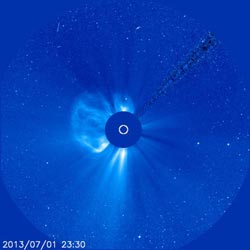Coronal Mass Ejection Headed Toward Mercury and Venus

On July 1, 2013, the sun erupted with a coronal mass ejection, or CME – shown here as the lighter-colored gas moving off to the left -- which soared off in the direction of Venus and Mars. This image was captured by the joint ESA/NASA Solar and Heliospheric Observatory. <br>Image Credit: ESA and NASA/SOHO<br>
Experimental NASA research models based on NASA’s Solar Terrestrial Relations Observatory show that the CME was not Earth-directed and it left the sun at around 570 miles per second.
The CME may, however, pass by NASA’s Messenger, Spitzer and STEREO-B satellites, and their mission operators have been notified.
There is only very slight particle radiation associated with this event, which is what would normally concern operators of interplanetary spacecraft, because the particles can trip computer electronics aboard interplanetary spacecraft.
If warranted, operators can put spacecraft into safe mode to protect the instruments from the solar material.
NOAA's Space Weather Prediction Center (http://swpc.noaa.gov) is the U.S. government's official source for space weather forecasts, alerts, watches and warnings.
Updates will be provided as needed.
Karen C. Fox
NASA's Goddard Space Flight Center, Greenbelt, Md.
Media Contact
All latest news from the category: Physics and Astronomy
This area deals with the fundamental laws and building blocks of nature and how they interact, the properties and the behavior of matter, and research into space and time and their structures.
innovations-report provides in-depth reports and articles on subjects such as astrophysics, laser technologies, nuclear, quantum, particle and solid-state physics, nanotechnologies, planetary research and findings (Mars, Venus) and developments related to the Hubble Telescope.
Newest articles

Properties of new materials for microchips
… can now be measured well. Reseachers of Delft University of Technology demonstrated measuring performance properties of ultrathin silicon membranes. Making ever smaller and more powerful chips requires new ultrathin…

Floating solar’s potential
… to support sustainable development by addressing climate, water, and energy goals holistically. A new study published this week in Nature Energy raises the potential for floating solar photovoltaics (FPV)…

Skyrmions move at record speeds
… a step towards the computing of the future. An international research team led by scientists from the CNRS1 has discovered that the magnetic nanobubbles2 known as skyrmions can be…





















